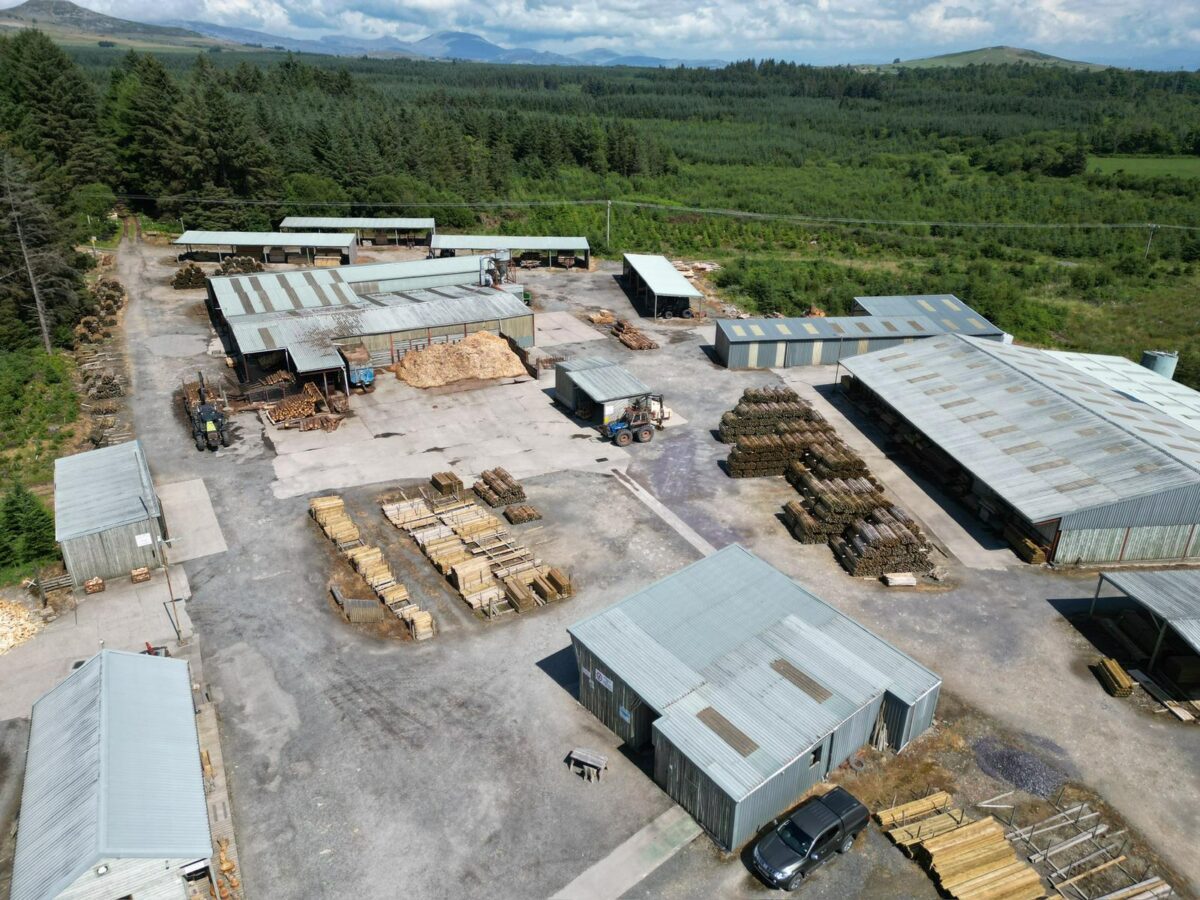From Seed To Sawmill
Glasfryn Fencing and Sawmill is situated just outside Llanaelhaearn on the edge of the Llyn Peninsula and has an interesting history behind it.
In 1952, aged just 25 and being the oldest son, Roger Williams-Ellis took over the running of the Glasfryn family estate following the death of his father Rupert. Prior to this Roger was commissioned into the Royal Engineers during WWII and spent his first three months aboard a troop ship bound for India. Once there he joined the Sapper Minors and rose rapidly to the rank of major, he was one of the youngest in the British Army at the time to hold that rank. When he was demobilised from the army he trained as a land surveyor in Denbigh until returning to Glasfryn.
Roger never drank or smoked and had always been careful with his money, so when poorer quality land became available on the north side of the river of the Glasfryn estate, he began to purchase it for himself to establish a forest. He was also a keen barterer; he had purchased 20 acres of good farmland which he swapped with a local farmer for 40 acres of poorer-quality, which was ideally suited for growing spruce trees. The land was quite acidic as it had a thick layer of peat on top of a clay subsoil. Getting the right crop was pivotal to his plans, as he believed that 40 years was a long time to live with a mistake if you planted the wrong species.
All the Sitka Spruce on the estate originate from seeds from the Queen Charlotte Islands (QCI) in British Columbia. Sitka is grown along the west coast of North America from California to Alaska. It is found up to about 80km from the coast as it thrives on a damp maritime climate. This specific area has a similar climate to the west coast of Wales. Roger tried some experimental planting with other tree species, but none faired quite as well as the Sitka.
I arranged to meet sawmill manager Arwel Roberts who had kindly offered to show us around the mill and explain a bit more about the history of the Glasfryn estate.
Arwel and Roger had been lifelong friends and when asked if he would establish and manage a sawmill on the estate, he jumped at the opportunity. Right at the start boundaries were set between the two, “In the mill, you’re the boss and in the forest, I’m the boss” stated Roger. Arwel smiles when he explained that it was a strange feeling telling your employer what to do whenever he was working in the mill.
We started our tour with the first tree that was planted on the estate in 1948, this involved a short journey by car to the heart of the forest. The tree is a magnificent specimen in amongst a beautiful stand of Sitka spruce and was more than 10m³. When Roger handed over the managing of the forest to Arwel his hope was that this tree would remain untouched. Arwel has certainly kept his word and all the trees surrounding this noble giant have all been given a protected status.
-
That’s a remarkable amount of work hours for a single machine, the Norcar 600 owned by Erkki Rinne is taken well care of, it even has the original Diesel engine.
-
Kieran Anders is a forestry contractor working in the lake district. His work involves hand cutting and extracting timber using a skidder and tractor-trailer forwarder.
-
It is not possible to eliminate chain shot, but there are simple steps that can be taken to reduce the risk.
-
Arwel takes great pride in the fact that the mill has no waste whatsoever, “the peelings are used for children’s playgrounds, gardens and for farm animals in barns in the winter and the sawdust has multiple uses in gardens and farms as well.
-
Timber hauliers need to encourage young blood in, and also look after the hauliers we have, we need make the sector a safe and positive place to work.
FIND US ON
Related Posts
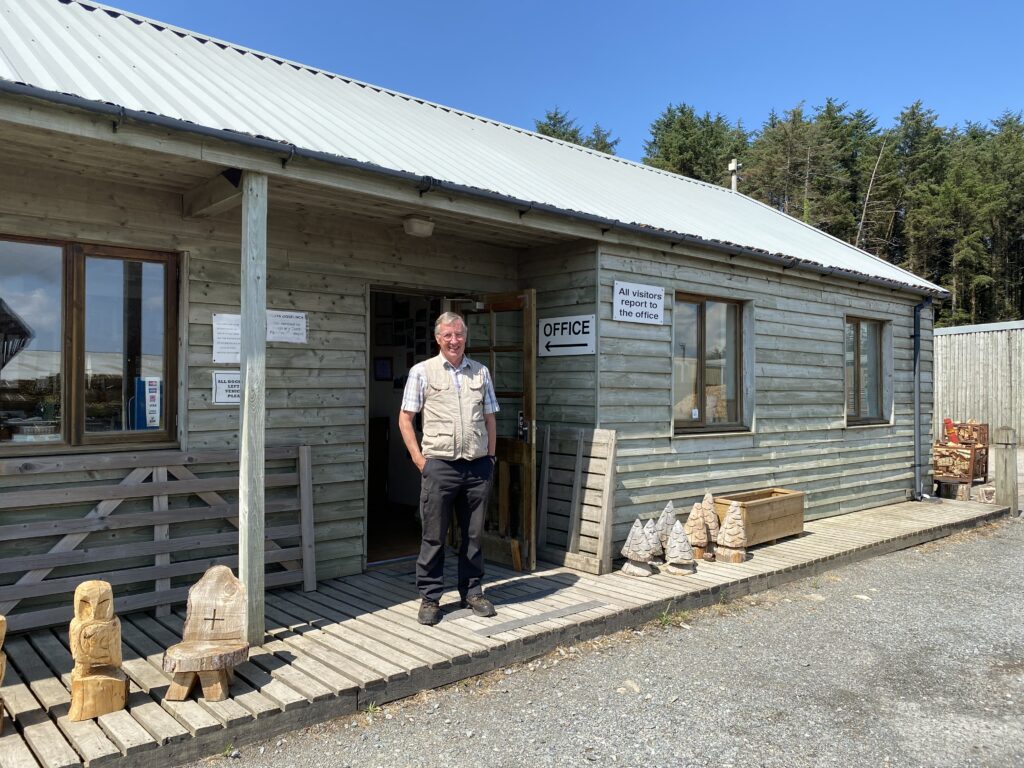

“Roger lived and breathed forestry” explained Arwel “his knowledge of trees was a pleasure to behold. He knew their common names, Latin names, soil types needed for each tree to grow properly and how to nurture and care for them.”
Whilst establishing the new commercial forest Roger also built up a very successful nursery which sold two to three million trees to private and investment foresters annually. When the tax relief on tree planting ended in 1973, it unfortunately spelled the beginning of the end for the nursery, and it closed almost overnight. Roger was devastated at having to lay off his staff, he managed to keep on one employee who worked well past his retirement age and into his eighties helping to look after the young trees that were growing.
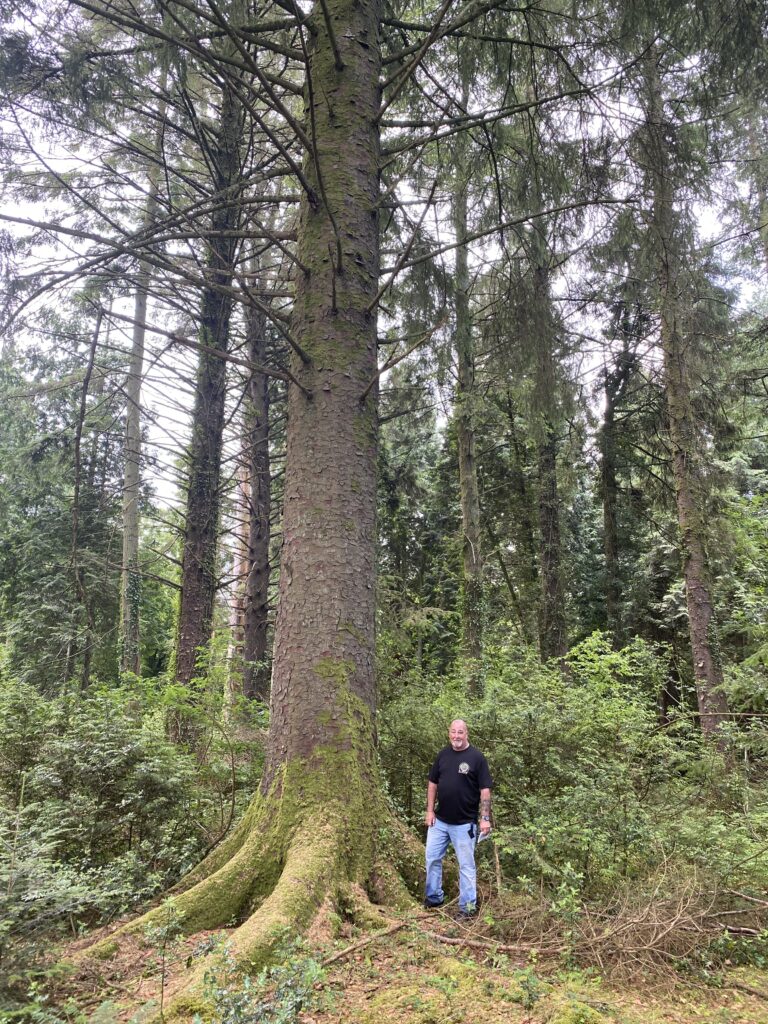

By this point, many of the trees were now ready for thinning and North Wales had two good markets for small roundwood.
Anglesey Aluminium, located on the outskirts of Holyhead, was a joint venture between Rio Tinto (a global mining group that finds and processes the Earths mineral resources) and Kaiser Aluminium. They produced 142,000 tonnes of Aluminium each year which was distributed all over the world from the port at Holyhead. The local firm took in thousands of round timber pokers; these were generally cut from spindly trees roughly 1-3” in diameter and around 12’ long. I remember cutting hundreds of these and hand balling them out of the forest. The first couple of feet were inserted into the furnace which helped to burn off any impurities when the Aluminium was being made. Roger approached Anglesey Aluminium regarding tendering as a supplier but he was turned down as he was considered too small a company. The Forestry Commission was the Aluminium company’s’ main supplier, so Roger sold his pokers to Anglesey Aluminium, but through the Forestry Commission.
One Saturday, the Aluminium firm were in desperate need of pokers and there was no one available at the Forestry Commission. The company contacted Roger and he agreed to help them out if they would allow him to tender for future contracts, this was agreed and the rest as they say is history. This benefited other small forest estates who were in the same boat as Roger had been in and they began to sell their pokers to him to supply to Anglesey Aluminium.
Glasfryn became one of the main suppliers of pokers for Anglesey Aluminium. Roger was also approached by another Aluminium producer who were on a visit from the middle east. They also wanted a continual supply of pokers and were happy to take thicker diameter timber which was easier to locate.
A good source of pokers came from the now obsolete nursery, being grown close together had created a good crop of spindly tall trees.
The pokers can also be attributed to the start of the fencing business. Some of
the trees were a bit too big in diameter for pokers so Glasfryn cut a piece off the bottom. The mill acquired a Cundy Peeler – which is still at the sawmill and is the oldest working Cundy peeler in existence. Cundy confirmed this themselves who in recognition, completely overhauled the peeler free of charge – a Massey Ferguson tractor and PTO driven McConnel saw bench and started peeling and pointing the posts. They were treated by being immersed in a Creosote bath once seasoned.
The other good market at that time was the Bowater pulp mill at Ellesmere Port which had opened in 1931. The large North American paper manufacturer took small roundwood in 1m lengths and produced almost 60% of British newsprint until its closure in 1980 when it went into administration. Timber loading cranes were in their infancy and most lorries were loaded by hand and double stacked lengthways. Unfortunately, the cost of hauling timber from the Llyn Peninsula to Bowater’s pulp mill meant timber would be sold at a loss so this was immediately discounted.
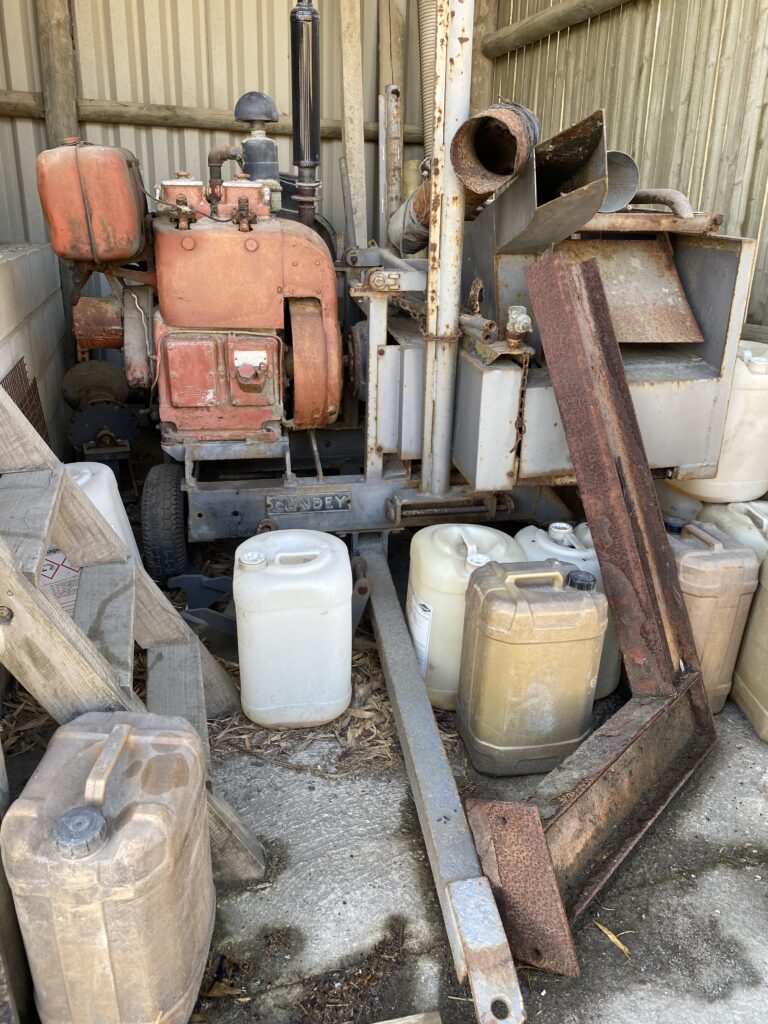

In the meantime, Roger had increased his foothold and now owned an impressive 800 acre forest. He also restored buildings on the estate. If he hadn’t chosen forestry, he would probably have forged a career as a rural architect as he collected multiple awards for his heritage work.
The poker market dried up when Anglesey Aluminium closed and there was no longer any demand from the Aluminium plants in the middle east.
It wasn’t all doom and gloom though for Glasfryn as the fencing market slowly increased. Roger approached Arwel regarding establishing the sawmill which was financed with the income from the pokers. Arwel smiled again when he recalled this “There had been several sawmills spread around the Llyn Peninsula, but they had all now closed due to cheap imported timber. Roger was undeterred by this and insisted that what the local farming community wanted was top quality fencing materials that would outlast any of the poorer quality imports that were currently available.”
Roger bought a second-hand treatment plant, but to achieve the quality they both required took time and resulted in a more expensive product. At the beginning, the farmers didn’t get the bigger picture and only saw a more expensive product.
Hindsight has proven that Roger and Arwel were right to insist on such a high quality product.
Access was a big problem that the duo had to overcome. A local farmer owned the land where the sawmill sits today and he was reluctant to sell. Roger asked the farmer to give him first refusal if he ever changed his mind and that he would outbid any other offers he received. Fortunately, the farmer did have a change of heart and Roger acquired the land.
On our way back to the mill I noticed quite a lot of timber stacked at roadside which was next to a recently clear-felled area.
“We have a forestry contractor, Dylan Taylor, who comes in and does our forestry work for us.” said Arwel “We are fortunate that we always have a good stock of timber seasoning so we can be flexible time wise when it comes to our felling programmes. We are pleased with the work that Dylan does for us, he not only does an excellent job of the harvesting, but he understands the importance of the quality of the wood we are looking for.”


I asked about Glasfryn’s harvesting system “We don’t thin out our trees but instead carry out clear-felling when the timber is around 35 years old. This is an ideal size for us as we get plenty of fencing material and some wood for milling. Fencing is our biggest market, so this suits us best. The type of ground we have here is quite boggy and soft so we would end up with a lot more premature windblown trees if we started a thinning regime.”
As we approached the sawmill, I saw a lot of poorer quality softwood and hardwood stacked up “Seasoned firewood has become a large part of the business now,” said Arwel, “there are so many people using wood for central heating in their stoves. We had a customer almost in tears a while ago, he had spent a fortune lining his chimney and installing a wood burner and central heating and had bought firewood from a local merchant. He couldn’t get any heat as the fire was just sizzling and kept going out. I asked him if he was using seasoned wood and the look of bewilderment on his face told me everything I needed to know. I gave him a bag of our seasoned wood to try, and he was back the following day beaming from ear to ear. He has been a regular firewood customer of ours ever since.”
Once back in the sawmill Arwel proudly showed us around. The first thing that struck me was just how tidy everywhere was. I had only given him a days’ notice of my visit, so it certainly hadn’t been done just for me. 😀 The yard is immaculate, the whole area has been concreted and is kept clean. All the round timber once peeled and pointed is stacked under shelters with open sides to help speed up the seasoning process prior to treatment. No matter where you looked everything was tidy and in its place.
Arwel takes great pride in the fact that the mill has no waste whatsoever, “the peelings are used for children’s playgrounds, gardens and for farm animals in barns in the winter and the sawdust has multiple uses in gardens and farms as well. The pointings from making posts are sold as firewood along with the outside edges when we are sawing boards or square posts, and rails and rejected timber is recycled to the forestry stack where it will be processed into logs.”
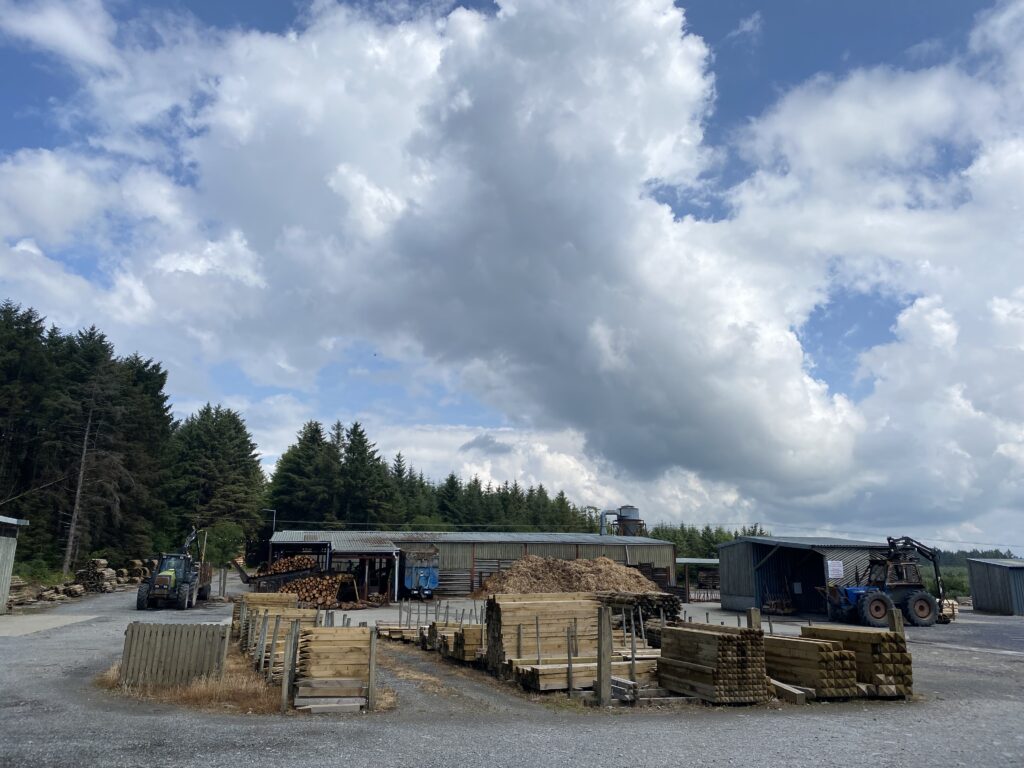

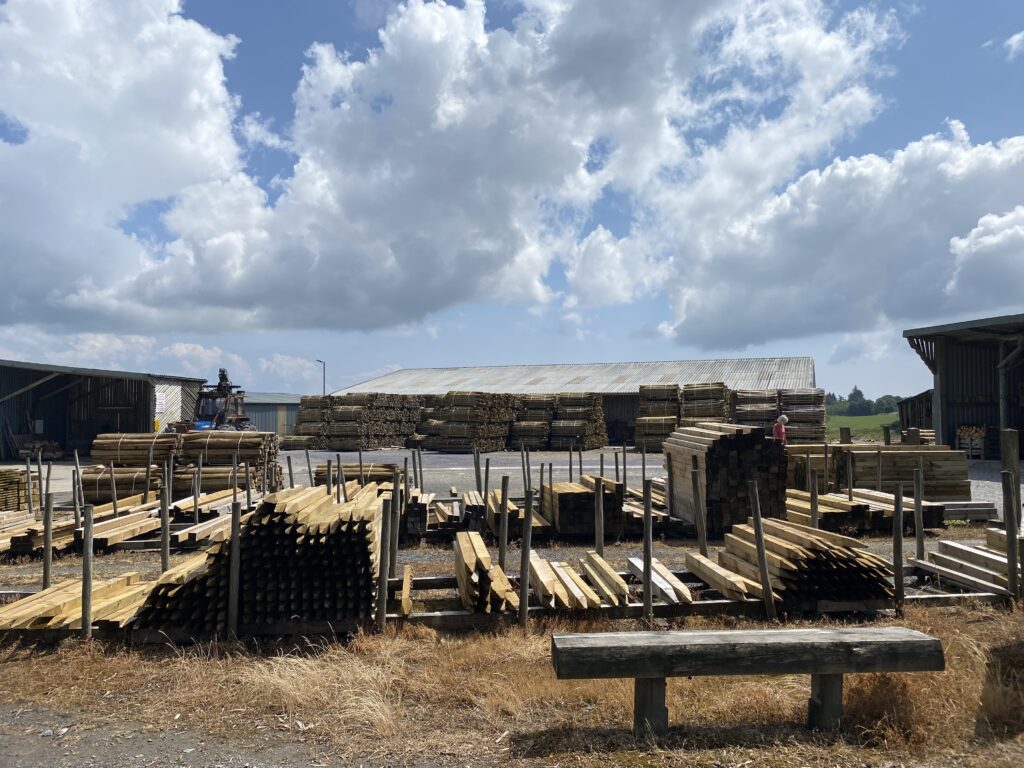

I asked Arwel about staff as I thought being in a rural location getting skilled workers wouldn’t be that easy. “We have been fortunate as we have no turnover of workers, all nine of our staff have been here for years. They get a lot of variation in their work which keeps the job interesting; there are so many different things to do, they never get bored. Most of our staff are from agricultural backgrounds and have been brought up with a can-do attitude. They always find a solution to problems and are hard workers with a good positive attitude.
“During Covid we had to shut down completely” explained Arwel “and we had to put our staff on furlough. We decided the sawmill would make up any shortfall in their wages between furlough and what they usually got.”
With that kind of approach, it’s no wonder they have a loyal and hard-working workforce!
Although production at the sawmill ceased during Covid, Arwel was still able to assist local farmers with any materials they had in stock. “During the pandemic we only supplied essential materials to regular customers, and we were able to adhere to Government guidelines. Customers phoned the sawmill office, which my wife Olwen manages, to place an order and I would put it together. I would then load it onto their trailers at the entrance with the forklift or drop it there for collection. They paid over the phone with their bank cards.
“It was after Covid we felt the impact, our stock was depleted and we had to start again from scratch. Our reputation is built on supplying quality timber, so we had to delay orders as we waited for our timber to season properly.”
While I was there the peeler was being used and this wasn’t just one pass through and off for pointing, the timber was being checked for quality, straightness, stress as well as being peeled. If the quality of the bark removal wasn’t satisfactory it was put through again until the operator was satisfied. Once peeled the timber was passed through a band saw and ripped in half or quarters before being pointed. At each of these stages the timber was further checked for stress.
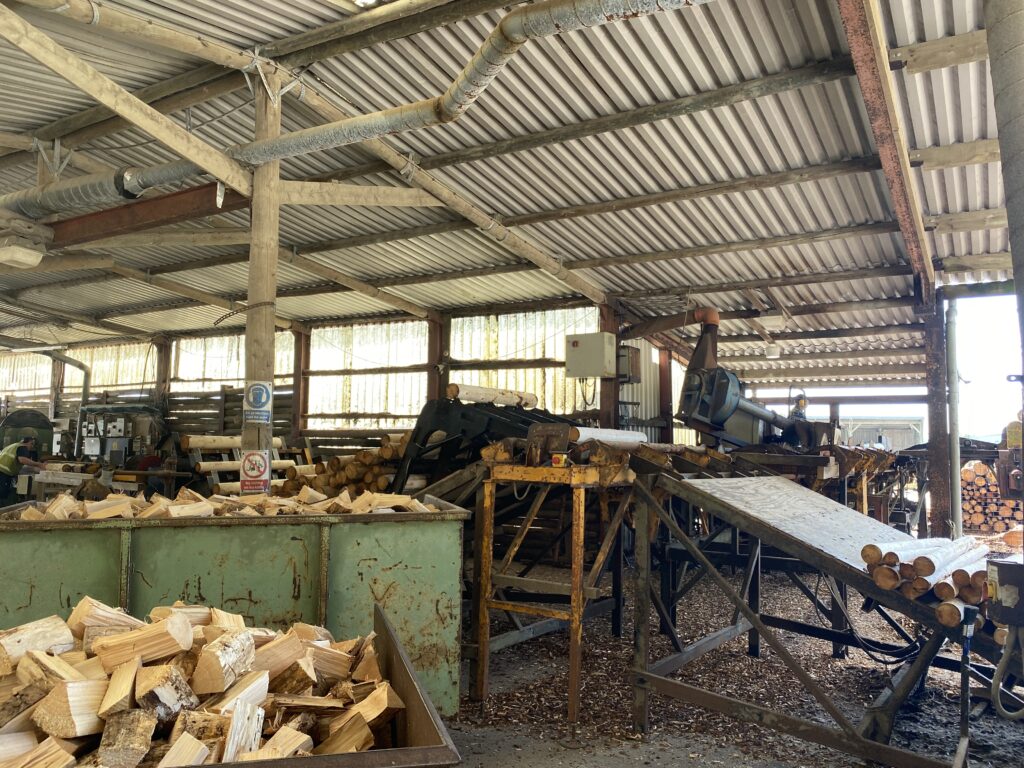



I asked Arwel why they were constantly looking for stress in the wood and he replied “Stressed wood doesn’t take the pressure treatment very well so won’t last as long. What’s the point of doing the job if you are not going to do it right.” he exclaimed.
All the timber is seasoned to around a 28% moisture content prior to pressure treatment, this can take anything from two to five months depending on the climate. Glasfryn have two treatment plants and can have two cycles in each tank each day if required.
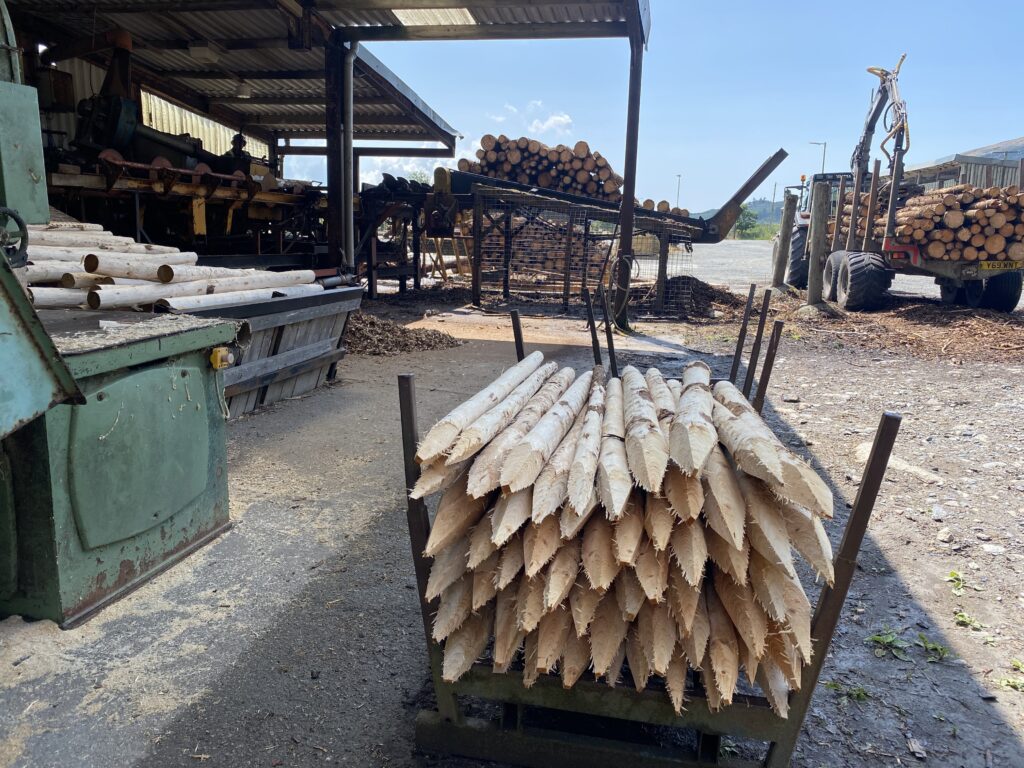





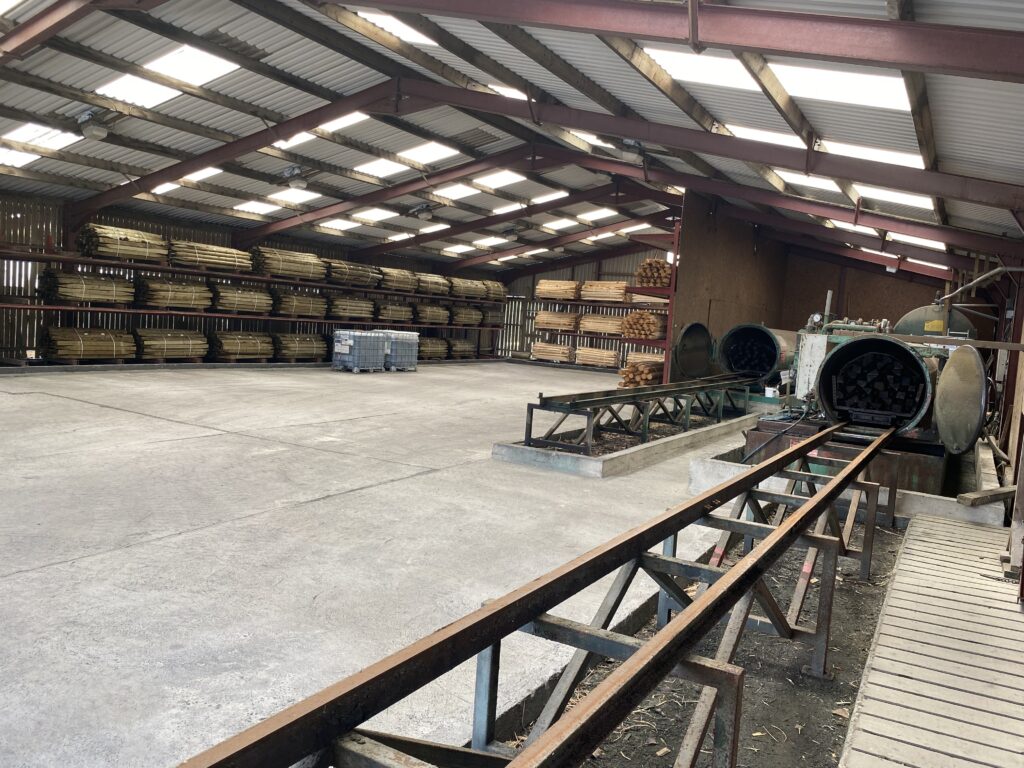

Next to the treatment plant is a large, fully equipped joiners’ workshop. A local joiner utilises this space on a part time basis and manufactures finished products which are for sale at the mill, these include stiles, gates, troughs, and garden furniture.
Two classic County tractors with roof mounted Botex Cranes, three Valtra’s one with a roof mounted Botex and trailer, one with a Botex trailer and crane and one with a timber trailer along with an ex-military Valmet with a front forklift loader are used for moving timber and loading the log decks. Just like everything else in the sawmill, the tractors were in excellent condition and very well maintained.
Another area of the sawmill was busy on firewood production, one of the county’s was loading poor quality hardwood timber onto the deck from the Valtra with the timber trailer. It was being cut and split with the large Dalen Firewood processor and then loaded into large wooden crates and then stored undercover.
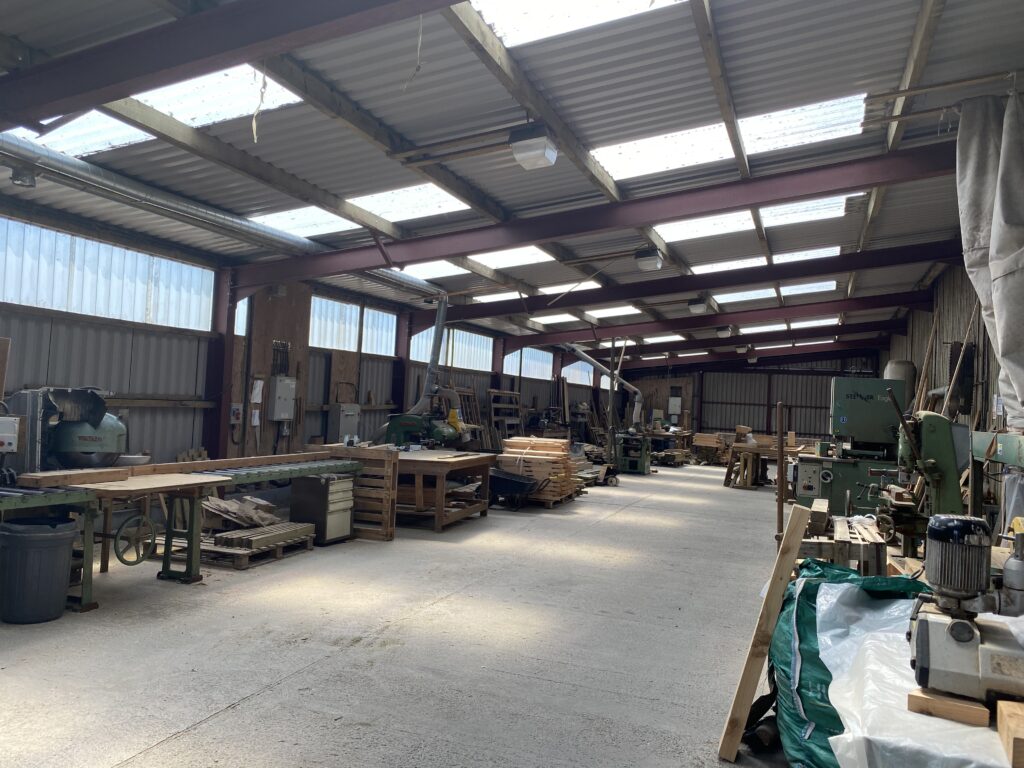

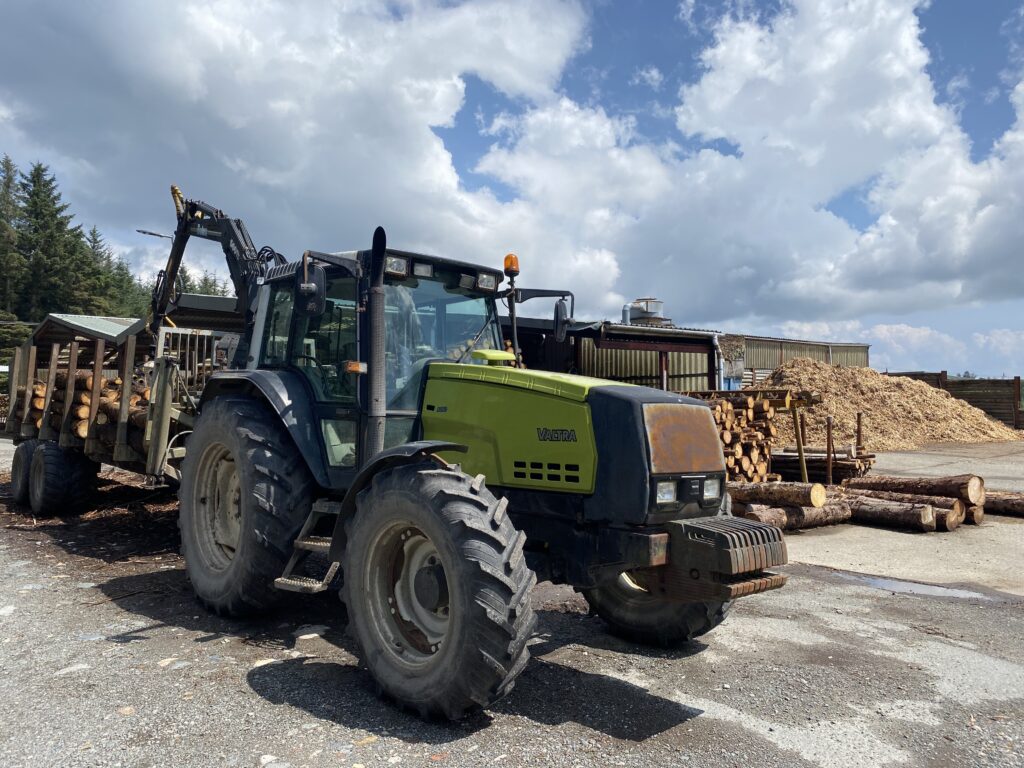

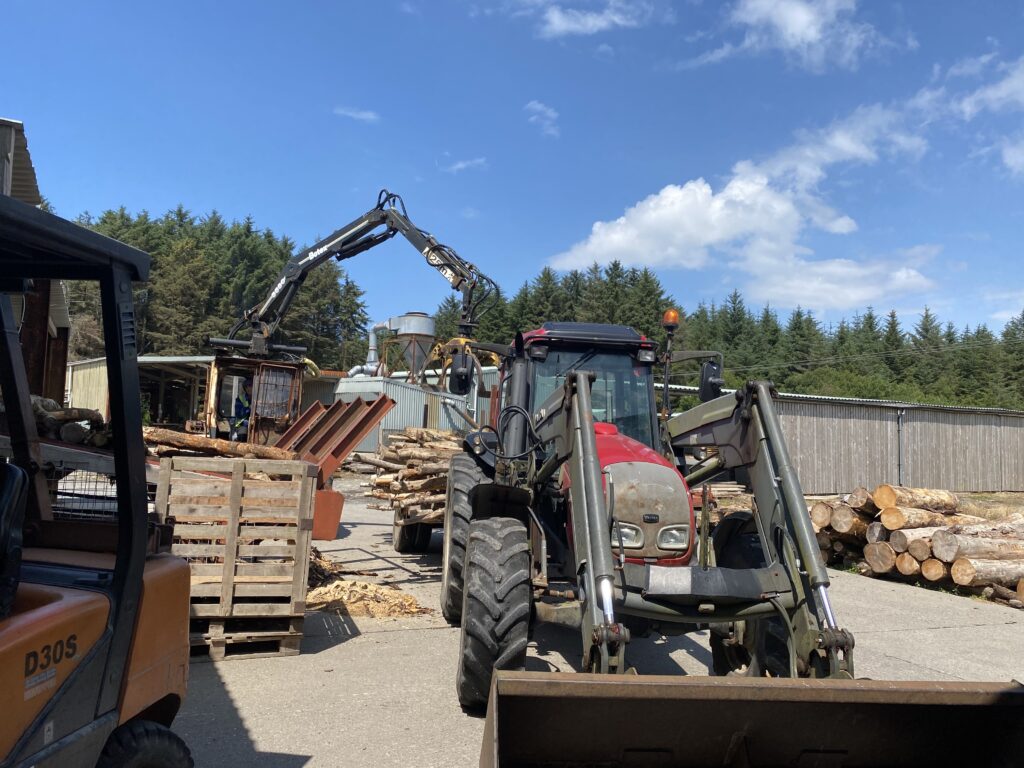

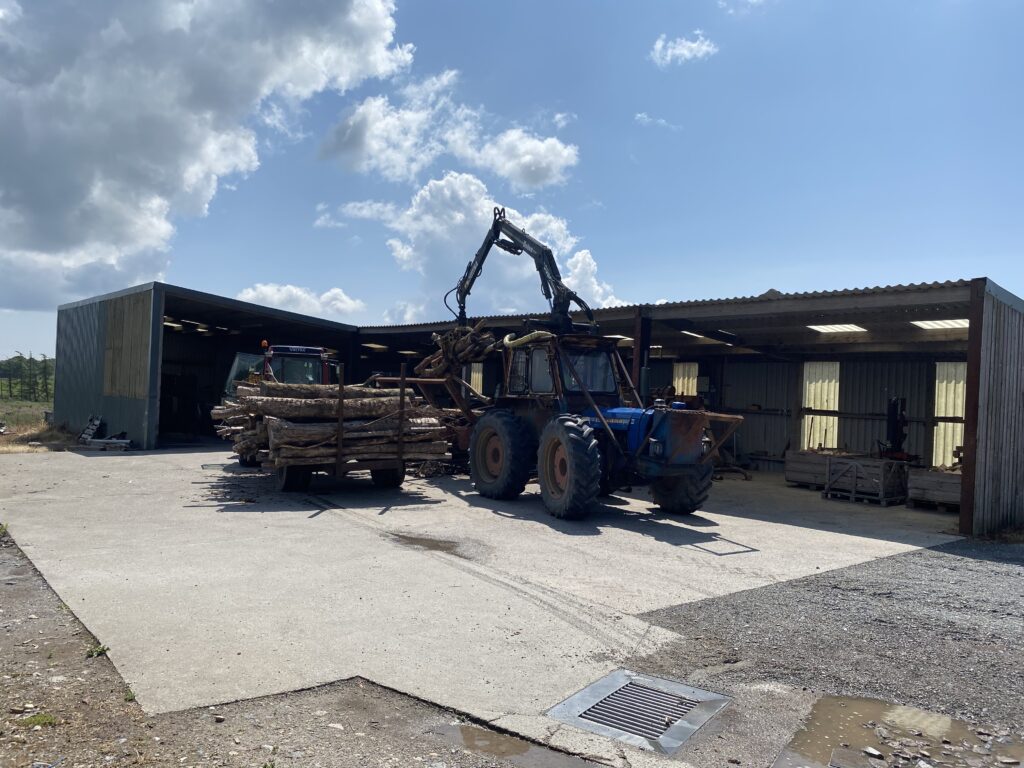

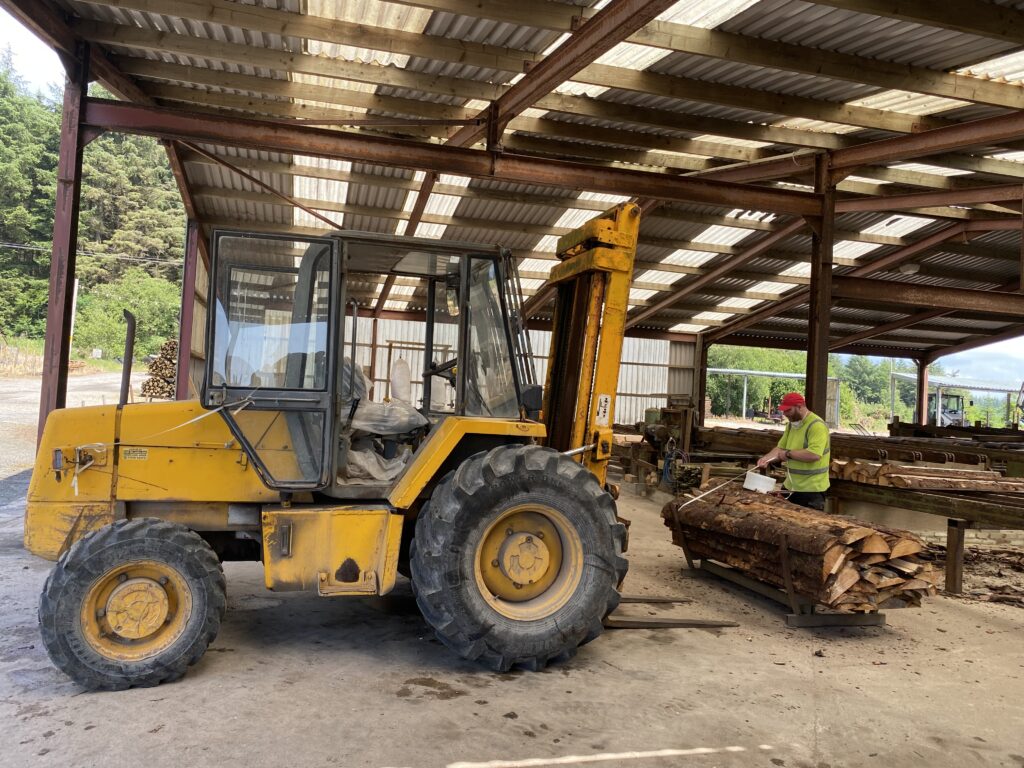



When Arwel isn’t around, his wife Olwen is next in command. Olwen started working on the paperwork when the mill was in its infancy. Roger was delighted with this and soon talked Olwen into joining the team but they agreed that work had to revolve around her and Arwel’s young daughter, who came first every time.
When unsure of anything, it is Olwen the staff go to for advice or reassurance. Again, Arwel laughs “Olwen is completely indispensable, she isn’t just the office manager, you will find her doing almost anything that’s needed in the yard apart from driving the County forwarder.”
Back in 2001 when the foot and mouth disease hit the UK the mill caught the attention of local Welsh TV station S4C. The broadcasting company came to see them about doing a programme on the sawmill for a weekly farming programme as they were not allowed near farms due to the risk of cross contamination.
Arwel agreed but only if the programme told the full story from the forest to the sawmill and reported the care and attention, that Glasfryn took in manufacturing fencing posts. Filming took a few days and it was aired the following Friday evening. The next morning the phone rang constantly and the office was inundated with orders. The programme had done a brilliant job of highlighting what was involved in growing a tree, right through to producing a seasoned fencing post. Farmers finally understood that buying the cheap posts cost more in the long run, as they rotted after a few years, whereas Glasfryn’s posts exceeded all expectations.
The mill was so busy that it took up to six months to complete some orders. The local farmers were undeterred and happy to wait for such a quality product. The mill eventually got back into a steady rhythm and although they are still very busy the waiting times from ordering to delivery are nowhere near as long. Fencing is Glasfryn’s biggest market followed by firewood and then sawn timber.
Christmas trees are another good source of income for the mill, people came from far and wide to buy their trees and it is a fun day out for all the family. The fresh-cut to order trees, ensure quality and longevity over the Christmas period, and importantly, are harvested in a way that ensures zero-waste. By not cutting in bulk, Glasfryn doesn’t create an excess of un-sold trees – meaning smaller trees that might have been cut down, continue to grow into larger Christmas trees for the following year. Some of the older growth trees that were sold reached as high as 30ft.
Today the complete estate stands at 1,000 acres. Roger Williams Ellis served as chairman of the Welsh Timber Growers Association and was awarded the OBE for his services to forestry. The Royal Welsh Agricultural Society
awarded him the Sir Bryner Jones Award in a ceremony at the Royal Welsh Show in Builth Wells for reaching the highest level of achievement in their chosen sector. Sadly, Roger died in 2018 aged 94. Since then Arwel and Olwen have done a magnificent job of keeping his legacy alive.
Arwel exudes passion for the sawmill and rightly so as he is the person responsible for making it the successful business it is today. He is also quick to point out how lucky Olwen is, “This has to be one of the best office views in the world” as he points over to Yr Eifl, the mountain range towering over them. “Not many office managers can boast a view like that from their desk” and I must admit it was hard to disagree.
Arwel has a wry smile when he explained that at one time some people criticised them for their monoculture forestry system. However, a visit from the RSPB soon quashed that. Bird species have been found in Glasfryn forest that the RSPB haven’t seen in a very long, time. The estate is not only a haven for wildlife but is also home to beehives which are beneficial to everyone.
No place was out of bounds on this trip and Arwel was very open and honest about everything to do with the mill. It was a privilege to be given such an insight into the day to day running, the history of the mill and the sense of achievement and pride Arwel has for what they manufacture.
I often hear the saying teamwork makes the dream work, but I’ve never quite seen it implemented as well as in this sawmill. It is a very successful mill, and it has taken hard graft, dedication, and close attention to detail by Roger, Arwel, Olwen and the rest of the team to achieve what they have today.
I grew up in north Wales and have many friends who are farmers. When it comes to purchasing fencing materials there is no one that I know that would go anywhere except Glasfryn Sawmill.
01758 750 623
www.glasfrynfencing.co.uk
Forest Machine Magazine is written and edited by a forest professional with over 40 years hands on experience. We are dedicated to keeping you informed with all the latest news, views and reviews from our industry.
To support us you can subscribe to our bi-monthly magazine which is delivered to your door from only £15 per year.
Subscribe here
#homeoflogging #writtenbyloggersforloggers #loggingallovertheworld
-

 1 Year Subscription£0.00
1 Year Subscription£0.00 -

 2 Year Subscription£0.00
2 Year Subscription£0.00 -

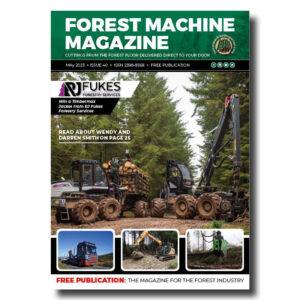 Issue 40£0.00
Issue 40£0.00 -

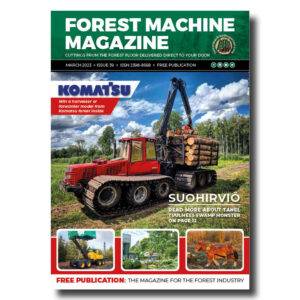 Issue 39£0.00
Issue 39£0.00 -

 Issue 41£0.00
Issue 41£0.00 -

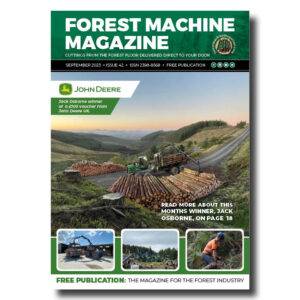 Issue 42£0.00
Issue 42£0.00

